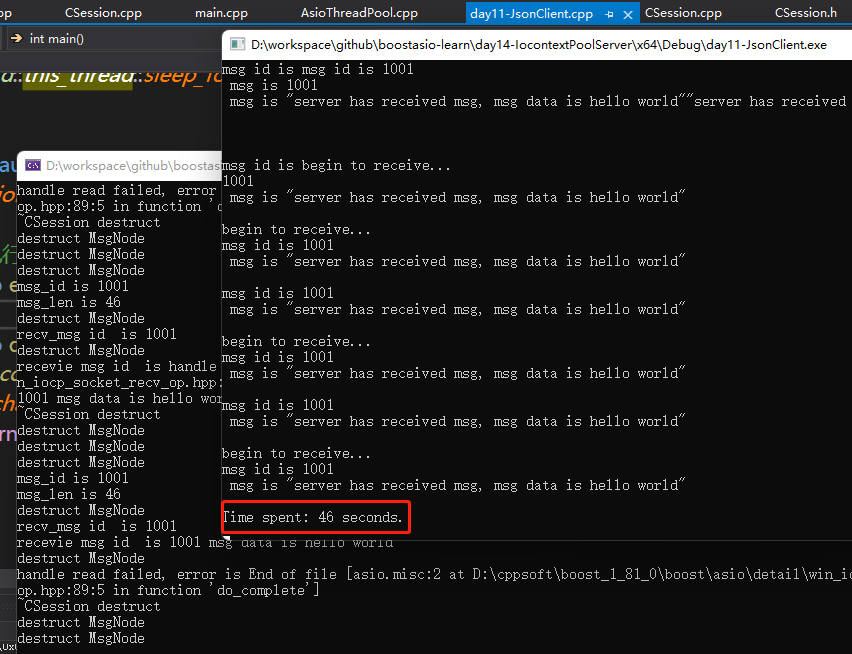简介
今天给大家介绍asio多线程模式的第二种,之前我们介绍了IOServicePool的方式,一个IOServicePool开启n个线程和n个iocontext,每个线程内独立运行iocontext, 各个iocontext监听各自绑定的socket是否就绪,如果就绪就在各自线程里触发回调函数。为避免线程安全问题,我们将网络数据封装为逻辑包投递给逻辑系统,逻辑系统有一个单独线程处理,这样将网络IO和逻辑处理解耦合,极大的提高了服务器IO层面的吞吐率。这一次介绍的另一种多线程模式IOThreadPool,我们只初始化一个iocontext用来监听服务器的读写事件,包括新连接到来的监听也用这个iocontext。只是我们让iocontext.run在多个线程中调用,这样回调函数就会被不同的线程触发,从这个角度看回调函数被并发调用了。
结构图
线程池模式的多线程模型调度结构图,如下
先实现IOThreadPool
#include <boost/asio.hpp>
#include "Singleton.h"
class AsioThreadPool:public Singleton<AsioThreadPool>
{
public:
friend class Singleton<AsioThreadPool>;
~AsioThreadPool(){}
AsioThreadPool& operator=(const AsioThreadPool&) = delete;
AsioThreadPool(const AsioThreadPool&) = delete;
boost::asio::io_context& GetIOService();
void Stop();
private:
AsioThreadPool(int threadNum = std::thread::hardware_concurrency());
boost::asio::io_context _service;
std::unique_ptr<boost::asio::io_context::work> _work;
std::vector<std::thread> _threads;
};
AsioThreadPool继承了Singleton<AsioThreadPool>,实现了一个函数GetIOService获取iocontext
接下来我们看看具体实现
#include "AsioThreadPool.h"
AsioThreadPool::AsioThreadPool(int threadNum ):_work(new boost::asio::io_context::work(_service)){
for (int i = 0; i < threadNum; ++i) {
_threads.emplace_back([this]() {
_service.run();
});
}
}
boost::asio::io_context& AsioThreadPool::GetIOService() {
return _service;
}
void AsioThreadPool::Stop() {
_work.reset();
for (auto& t : _threads) {
t.join();
}
}
构造函数中实现了一个线程池,线程池里每个线程都会运行_service.run函数,_service.run函数内部就是从iocp或者epoll获取就绪描述符和绑定的回调函数,进而调用回调函数,因为回调函数是在不同的线程里调用的,所以会存在不同的线程调用同一个socket的回调函数的情况。
_service.run 内部在Linux环境下调用的是epoll_wait返回所有就绪的描述符列表,在windows上会循环调用GetQueuedCompletionStatus函数返回就绪的描述符,二者原理类似,进而通过描述符找到对应的注册的回调函数,然后调用回调函数。
比如iocp的流程是这样的
IOCP的使用主要分为以下几步:
1 创建完成端口(iocp)对象
2 创建一个或多个工作线程,在完成端口上执行并处理投递到完成端口上的I/O请求
3 Socket关联iocp对象,在Socket上投递网络事件
4 工作线程调用GetQueuedCompletionStatus函数获取完成通知封包,取得事件信息并进行处理
epoll的流程是这样的
1 调用epoll_creat在内核中创建一张epoll表
2 开辟一片包含n个epoll_event大小的连续空间
3 将要监听的socket注册到epoll表里
4 调用epoll_wait,传入之前我们开辟的连续空间,epoll_wait返回就绪的epoll_event列表,epoll会将就绪的socket信息写入我们之前开辟的连续空间
隐患
IOThreadPool模式有一个隐患,同一个socket的就绪后,触发的回调函数可能在不同的线程里,比如第一次是在线程1,第二次是在线程3,如果这两次触发间隔时间不大,那么很可能出现不同线程并发访问数据的情况,比如在处理读事件时,第一次回调触发后我们从socket的接收缓冲区读数据出来,第二次回调触发,还是从socket的接收缓冲区读数据,就会造成两个线程同时从socket中读数据的情况,会造成数据混乱。
利用strand改进
对于多线程触发回调函数的情况,我们可以利用asio提供的串行类strand封装一下,这样就可以被串行调用了,其基本原理就是在线程各自调用函数时取消了直接调用的方式,而是利用一个strand类型的对象将要调用的函数投递到strand管理的队列中,再由一个统一的线程调用回调函数,调用是串行的,解决了线程并发带来的安全问题。
图中当socket就绪后并不是由多个线程调用每个socket注册的回调函数,而是将回调函数投递给strand管理的队列,再由strand统一调度派发。
为了让回调函数被派发到strand的队列,我们只需要在注册回调函数时加一层strand的包装即可。
在CSession类中添加一个成员变量
strand<io_context::executor_type> _strand;
CSession的构造函数
CSession::CSession(boost::asio::io_context& io_context, CServer* server):
_socket(io_context), _server(server), _b_close(false),
_b_head_parse(false), _strand(io_context.get_executor()){
boost::uuids::uuid a_uuid = boost::uuids::random_generator()();
_uuid = boost::uuids::to_string(a_uuid);
_recv_head_node = make_shared<MsgNode>(HEAD_TOTAL_LEN);
}
可以看到_strand的初始化是放在初始化列表里,利用io_context.get_executor()返回的执行器构造strand。
因为在asio中无论iocontext还是strand,底层都是通过executor调度的,我们将他理解为调度器就可以了,如果多个iocontext和strand的调度器是一个,那他们的消息派发统一由这个调度器执行。
我们利用iocontext的调度器构造strand,这样他们统一由一个调度器管理。在绑定回调函数的调度器时,我们选择strand绑定即可。
比如我们在Start函数里添加绑定 ,将回调函数的调用者绑定为_strand
void CSession::Start(){
::memset(_data, 0, MAX_LENGTH);
_socket.async_read_some(boost::asio::buffer(_data, MAX_LENGTH),
boost::asio::bind_executor(_strand, std::bind(&CSession::HandleRead, this,
std::placeholders::_1, std::placeholders::_2, SharedSelf())));
}
同样的道理,在所有收发的地方,都将调度器绑定为_strand, 比如发送部分我们需要修改为如下
auto& msgnode = _send_que.front();
boost::asio::async_write(_socket, boost::asio::buffer(msgnode->_data, msgnode->_total_len),
boost::asio::bind_executor(_strand, std::bind(&CSession::HandleWrite, this, std::placeholders::_1, SharedSelf()))
);
回调函数的处理部分也做对应的修改即可。
性能对比
为了比较两种服务器多线程模式的性能,我们还是利用之前测试的客户端,客户端每隔10ms建立一个连接,总共建立100个连接,每个连接收发500次,总计10万个数据包,测试一下性能。
客户端测试代码如下
#include <iostream>
#include <boost/asio.hpp>
#include <thread>
#include <json/json.h>
#include <json/value.h>
#include <json/reader.h>
#include <chrono>
using namespace std;
using namespace boost::asio::ip;
const int MAX_LENGTH = 1024 * 2;
const int HEAD_LENGTH = 2;
const int HEAD_TOTAL = 4;
std::vector<thread> vec_threads;
int main()
{
auto start = std::chrono::high_resolution_clock::now(); // 获取开始时间
for (int i = 0; i < 100; i++) {
vec_threads.emplace_back([]() {
try {
//创建上下文服务
boost::asio::io_context ioc;
//构造endpoint
tcp::endpoint remote_ep(address::from_string("127.0.0.1"), 10086);
tcp::socket sock(ioc);
boost::system::error_code error = boost::asio::error::host_not_found; ;
sock.connect(remote_ep, error);
if (error) {
cout << "connect failed, code is " << error.value() << " error msg is " << error.message();
return 0;
}
int i = 0;
while (i < 500) {
Json::Value root;
root["id"] = 1001;
root["data"] = "hello world";
std::string request = root.toStyledString();
size_t request_length = request.length();
char send_data[MAX_LENGTH] = { 0 };
int msgid = 1001;
int msgid_host = boost::asio::detail::socket_ops::host_to_network_short(msgid);
memcpy(send_data, &msgid_host, 2);
//转为网络字节序
int request_host_length = boost::asio::detail::socket_ops::host_to_network_short(request_length);
memcpy(send_data + 2, &request_host_length, 2);
memcpy(send_data + 4, request.c_str(), request_length);
boost::asio::write(sock, boost::asio::buffer(send_data, request_length + 4));
cout << "begin to receive..." << endl;
char reply_head[HEAD_TOTAL];
size_t reply_length = boost::asio::read(sock, boost::asio::buffer(reply_head, HEAD_TOTAL));
msgid = 0;
memcpy(&msgid, reply_head, HEAD_LENGTH);
short msglen = 0;
memcpy(&msglen, reply_head + 2, HEAD_LENGTH);
//转为本地字节序
msglen = boost::asio::detail::socket_ops::network_to_host_short(msglen);
msgid = boost::asio::detail::socket_ops::network_to_host_short(msgid);
char msg[MAX_LENGTH] = { 0 };
size_t msg_length = boost::asio::read(sock, boost::asio::buffer(msg, msglen));
Json::Reader reader;
reader.parse(std::string(msg, msg_length), root);
std::cout << "msg id is " << root["id"] << " msg is " << root["data"] << endl;
i++;
}
}
catch (std::exception& e) {
std::cerr << "Exception: " << e.what() << endl;
}
});
std::this_thread::sleep_for(std::chrono::milliseconds(10));
}
for (auto& t : vec_threads) {
t.join();
}
// 执行一些需要计时的操作
auto end = std::chrono::high_resolution_clock::now(); // 获取结束时间
auto duration = std::chrono::duration_cast<std::chrono::seconds>(end - start); // 计算时间差,单位为微秒
std::cout << "Time spent: " << duration.count() << " seconds." << std::endl; // 输
getchar();
return 0;
}
我们先启动之前实现的AsioIOServicePool多线程模式的服务器测试,10万个数据包收发完成总计46秒
接下来我们启动ASIOThreadPool多线程模式的服务器测试,10万个数据包收发完成总计53秒
可以看出今天实现的多线程模式较之前的IOServicePool版本慢了7秒
取舍
实际的生产和开发中,我们尽可能利用C++特性,使用多核的优势,将iocontext分布在不同的线程中效率更可取一点,但也要防止线程过多导致cpu切换带来的时间片开销,所以尽量让开辟的线程数小于或等于cpu的核数,从而利用多核优势。
视频连接https://space.bilibili.com/271469206/channel/collectiondetail?sid=313101






